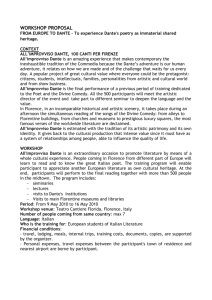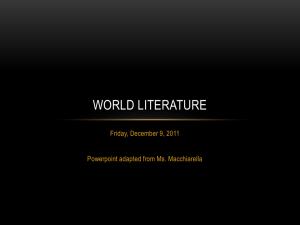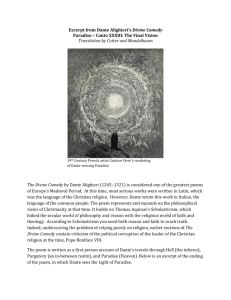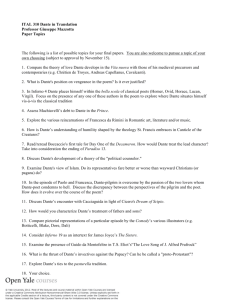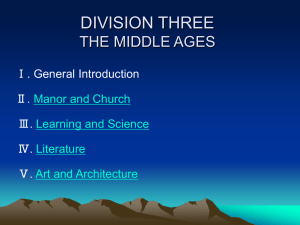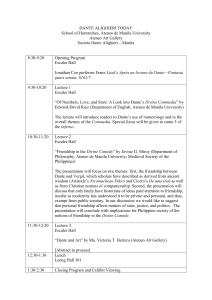Dante Alighieri of Florence: civis illustris et immeritus exul
advertisement
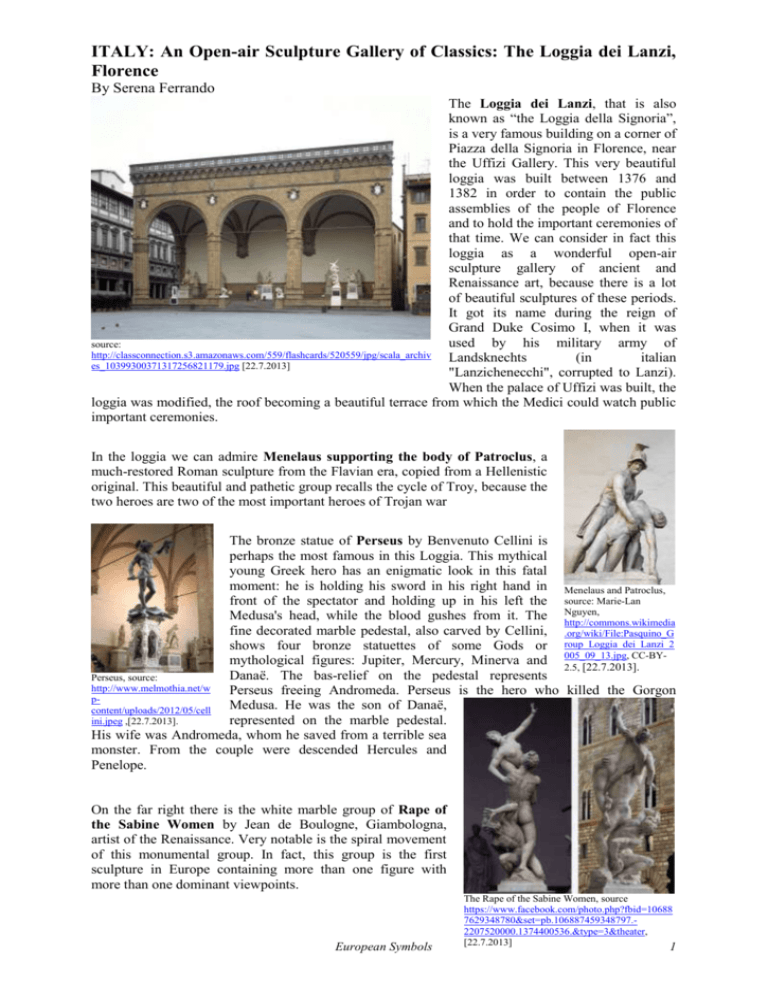
ITALY: An Open-air Sculpture Gallery of Classics: The Loggia dei Lanzi, Florence By Serena Ferrando The Loggia dei Lanzi, that is also known as “the Loggia della Signoria”, is a very famous building on a corner of Piazza della Signoria in Florence, near the Uffizi Gallery. This very beautiful loggia was built between 1376 and 1382 in order to contain the public assemblies of the people of Florence and to hold the important ceremonies of that time. We can consider in fact this loggia as a wonderful open-air sculpture gallery of ancient and Renaissance art, because there is a lot of beautiful sculptures of these periods. It got its name during the reign of Grand Duke Cosimo I, when it was used by his military army of source: http://classconnection.s3.amazonaws.com/559/flashcards/520559/jpg/scala_archiv Landsknechts (in italian es_10399300371317256821179.jpg [22.7.2013] "Lanzichenecchi", corrupted to Lanzi). When the palace of Uffizi was built, the loggia was modified, the roof becoming a beautiful terrace from which the Medici could watch public important ceremonies. In the loggia we can admire Menelaus supporting the body of Patroclus, a much-restored Roman sculpture from the Flavian era, copied from a Hellenistic original. This beautiful and pathetic group recalls the cycle of Troy, because the two heroes are two of the most important heroes of Trojan war The bronze statue of Perseus by Benvenuto Cellini is perhaps the most famous in this Loggia. This mythical young Greek hero has an enigmatic look in this fatal moment: he is holding his sword in his right hand in Menelaus and Patroclus, front of the spectator and holding up in his left the source: Marie-Lan Medusa's head, while the blood gushes from it. The Nguyen, http://commons.wikimedia fine decorated marble pedestal, also carved by Cellini, .org/wiki/File:Pasquino_G shows four bronze statuettes of some Gods or roup_Loggia_dei_Lanzi_2 CC-BYmythological figures: Jupiter, Mercury, Minerva and 005_09_13.jpg, 2.5, [22.7.2013]. Danaë. The bas-relief on the pedestal represents Perseus, source: http://www.melmothia.net/w Perseus freeing Andromeda. Perseus is the hero who killed the Gorgon pMedusa. He was the son of Danaë, content/uploads/2012/05/cell represented on the marble pedestal. ini.jpeg ,[22.7.2013]. His wife was Andromeda, whom he saved from a terrible sea monster. From the couple were descended Hercules and Penelope. On the far right there is the white marble group of Rape of the Sabine Women by Jean de Boulogne, Giambologna, artist of the Renaissance. Very notable is the spiral movement of this monumental group. In fact, this group is the first sculpture in Europe containing more than one figure with more than one dominant viewpoints. European Symbols The Rape of the Sabine Women, source https://www.facebook.com/photo.php?fbid=10688 7629348780&set=pb.106887459348797.2207520000.1374400536.&type=3&theater, [22.7.2013] 1 Eutropius, Breviarium Historia Romanae, I,1: The Rape of the Sabine Women 1 5 10 Condita civitate, quam ex nomine suo Romam vocavit, 1. recipio, -ere, -cepi, -ceptus: take; haec fere egit. Multitudinem finitimorum in civitatem recepit1, centum ex senioribus legit, quorum consilio omnia ageret, quos senatores nominavit propter senectutem . Tum, cum uxores ipse et populus suus non haberent, invitavit ad spectaculum ludorum vicinas2 urbi Romae nationes3 atque earum virgines rapuit. Commotis bellis propter raptarum iniuriam Caeninenses vicit, Antemnates, Crustuminos, Sabinos, Fidenates, Veientes . Haec omnia oppida urbem cingunt. Et cum orta subito tempestate non comparuisset4, anno regni tricesimo 2. vicinus 3: contiguous; 3. natio, -onis f.: tribe; septimo ad deos transisse creditus5 est5 et consecratus. Deinde Romae per6 quinos dies6 senatores imperaverunt et his regnantibus annus unus completus est. 4. compareo, -ere, -parui: be visible, appear; 5. creditus est: he was believed; 6. per quinos dies: by periods of five days each; Comments: 5: senectutem: This is the first mention of the Senate, from senex, “old man”. 8-9: Caeninenses, Antemnates, Crustumini, Sabini, Fidenates, Veientes: These are the tribes of Etruscan origin all around ancient Rome, all. Hercules and Nessus, source: http://itphoto500x500.mnstatic.com/statuadi-ercole-e-il-centauro-nesso_230061.jpg, [22.7.2013]. Here there is also Hercules beating the Centaur Nessus (1599). Hercules and his wife Deianira had to cross a river and the centaur Nessus was the only one who can help them. When the centaur picked up Deianira, he tried to do violence to her. Then Hercules killed him, but before he died the centaur told Deianira to preserve his blood, telling her that it had magical properties to induce love. But it was a lie: instead it was a potent and deadly poison. So when she soaked the tunica of Hercules with this blood in order to preserve his love for her, the hero died with terrible suffering. The Rape of Polyxena is another very famous group of statues in this Loggia. Polyxena was the young and beautiful daughter of Priam and Hecuba. This young girl is not present in homeric tradition, but she was invented by tragedians in the classical period and was imagined as a parallel to Iphigenia. Dante (Inf. V, 65-66) thinks that Achilles was a victim of love because he died for the love of Polyxena. He went in fact to the temple of Apollo in order to marry her but here he was killed by the arrows of Paris. Neoptolemus, his son, then sacrificed Polyxena to honour his dead father. The Rape of Polyxena, source: http://media.i.focus.it/2012/11/d9fc38b9-6ceb48f8-a110-13eb54cb4a13_590_590_0.JPG, [22.7.2013] Questions and tasks 1. Which myths are represented by the statues of the “Loggia dei Lanzi” in Florence? 2. Describe the statue of “The rape of the Sabine women” and compare it with the text of Eutropius. 3. Find other classical representations (statues, pictures, mosaics…) of the myth of Perseus and Medusa on the Web and describe the difference between them and the statue of Benvenuto Cellini. European Symbols 2 Dante Alighieri of Florence: civis illustris et immeritus exul Dante Alighieri is perhaps the most important poet and writer of Italian Literature. He was born in Florence in 1265 and in his first years of literary activity he was involved in the group of ‘poeti del dolce stil novo’, with Guido Cavalcanti and Guido Guinizzelli. Their poems were in fact only about love and about the women they loved. As he matured, Dante began his political career and became a very important representative of the Guelfi Bianchi, at this time in a continous struggle with the Guelfi Neri. Political affairs were in the Medieval Period the most important reason for ideological divisions. When therefore the Guelfi Neri of Corso Donati, the personal enemies of Dante, became the most important political party in the Dante, source: administration of the Comune of Florence, Dante and others were exiled http://4.bp.blogspot.com/from the city. In the first years of his exile he was with his friends, but after qhVaY3HkrxQ/TXUbgRa while he chose to be by himself and had a very sad and difficult life, H8hI/AAAAAAAAADQ/hWF nhmm2cYc/s1600/dante.jpg, because at this time it was very dangerous to help a person who had been [22.7.2013]. exiled. So, after some very difficult times, he enjoyed a better life thanks to the help of Moroello Malaspina in Lunigiana and Cangrande della Scala in Verona. At the end of his life, Dante was the guest of Guido Novello da Polenta in Ravenna, where he died in 1321. Among his most famous works are the Divina Commedia, where he imagines a fantastic journey through the afterlife; De vulgari eloquentia, in favour of the sermo vulgaris instead of sermo latinus; the Convivio, where he speaks about cultura and sapientia; De monarchia, where he explains his political theories about imperator and pope, two ‘suns’ that have in his mind the same power, and are therefore distinct from one another. Fhilippi Villani Liber de civitatis Florentiae famosis civibus ex codice Mediceo Laurentiano nunc primum editus et de Florentinorum litteratura principes fere synchroni scriptores cura et studio Gustavi Camilli Galletti, Florentiae MDCCCXLVII, Joannes Mazzoni excudebat, p. 11. Writing about the important personalities of Florence, Filippo Villani, an important chronicler of the medieval age, speaks about the death of Dante. 1 5 10 15 20 Obiit poëta anno MCCCXXI idibus Septembris, quo die Sanctae Crucis solemnitas1 celebratur, dierum2 vitae suae anno sexto et quinquagesimo, et apud vestibulum Fratrum3 Minorum3, eminenti conditus est sepulcro: non equidem4 quo tantum decuerit5 virum, sed quale pro6 repentino7 interitu in tanto rerum turbine8 potuit ocius9 inveniri. Decreverat vir nobilis Guido Novellus ex operoso10 marmore amplissimo sumptu11 erigere monumentum, quo egregii poetae cineres conderentur12; sed amici propositum13 infelix frustravit eventus14, fortunis Guidonis in deterius15 commutatis. Quae tamen interim potuit viri nobilis diligentia adimplevit16: curavit siquidem17, ut per multos <amicos> pro6 cuiusque arbitrio ponendi18 versus in sepulcro in poëtae laudem dictarentur19; hos <versus> iussit in frontispicio20 sollemnis arculae21 insigniri22: Theologus Dantes nullius dogmatis23 expers24, quod foveat25 claro philosophia sinu26. Gloria Musarum: vulgo gratissimus auctor, hic iacet, et fama pulsat27 utrumque polum. European Symbols 1. sollemnitas, -tatis. f.: religious service; 2. dies, diei. m.: time; recipio, -ere, -cepi, -ceptus: take; 3. Fratres Minores: the friars of St. Francis; 4. equidem: adv.: indeed; 5. deceo, ere, -ui: to become, to be becoming (coni. potentialis); 6. pro: according to, considering; 7. repentinus 3: sudden; 8. turbo, -inis m.: confusion; 9. ocius: adv.: rather quickly; 10. operosus 3: elaborate; 11. sumptus, us. m.: expense; 12. condo, -ere, didi, -ditus: bury; 13. propositum, -i n.: scheme, plan; 14. eventus, -us m.: happening; 15. in deterius: for the worse; 16. adimpleo, -ere,-evi, -etus: fulfil, provide completely; 17. siquidem: adv.: indeed; 18. pono, -ere, posui, positus: set; 19. dicto 1: get written down; 20. frontispicium, -i. n.: front illustration (of the urn); 21. arcula, ae f.: small urn; 22. insignio 4: mark; 23. dogma, -atis n.: philosophical tenet; 24. expers, -ertis (+ Gen.): being without; 25. foveo, -ere, fovi, fotus: cherish; 26. sinus, -us m.: lap; 27. pulso 1: strike, move, impress; 28. defuncti, - orum. m.: the dead; 3 Qui loca defunctis28, gladiis regnumque gemellis29 Distribuit30, laicis31 rhetoricisque modis31. 25 30 Pascua32 Pieriis33 demum34 resonabat35 avenis36, Atropos heu laetum livida37 rupit38 opus. Huic ingrata tulit tristem Florentia fructum39, Exilium, nato patria cruda40 suo, quem pia Guidonis gremio41 Ravenna Novelli gaudet honorati continuisse42 ducis. Mille trecentenis ter septem numinis annis, ad sua septembris idibus astra redit. 29. gemellus 3: twin; 30. distribuo, -ere, -bui, -butus: assign; 31. laicis rhetoricisque modis: in vernacular verses; 32. pascuum, -i n.: pasture land; 33. Pierius 3: from Mount Pierus, Thessalian, sacred to the Muses; 34. demum: adv.: lastly; 35. resono 1: make resound 36. avena, -ae f.: shepherd’s pipe, pan pipe; 37. lividus 3: envious 38. rumpo, -ere, rupi, ruptus: interrupt, break off; 39. fructus, -us m.: fruit, profit; 40. crudus 3: harsh; 41. gremium, -i n.: bosom; 42. contineo, -ere, -ui, -tentus: keep, gather; Comments: 2 Sanctae Crucis: Santa Croce is the most important church in Florence where the most important personalities of Italian culture are buried. 3-4 vestibulum Fratrum Minorum: Dante died in Ravenna, where he was the guest of Guido Novello da Polenta, a very important authority in this city. The friars of St. Francis offered a place near their monastery in order to bury him. Today the sepulcrum Dantis is still in Ravenna, in the same place, and visited and honoured by many people. 6 rerum turbine means that his death caught all his friends and parents by surprise. In fact, at this time Dante was still exiled from Florence and the guest of Ravenna, after having been welcomed in Verona by Cangrande della Scala, to whom he dedicated the Paradiso. 7 Guido Novellus: He was Dante’s host and friend in Ravenna. 10 infelix eventus: the poet’s death 19 auctor: The people of Italy loved Dante and he was beloved by the Musae, but, as he says with similar words in Inf. II, he was “a friend of Beatrice and he was not a friend of destiny”, because he was infelix exul. 20 iacet…pulsat: If Dante lies,here his fama reaches all parts of the world: these two images (poëta iacet/fama pulsat) are in strong antithesis. 21-22 loca…distribuit: Dante described the hereafter in his Divina Commedia, Hell, Purgatory and Paradise. 22 laicis rhetoricisque modis: this means that Dante composed his Divina Commedia in sermo vulgaris, not in Latin, in which all theological works at his time were composed. Dante discussed the question of literary language also in De vulgari eloquentia and Convivio. He composed also some important works in Latin, such as the same De vulgari eloquentia and De monarchia, but was convinced that the new culture of his time had to be expressed in sermo vulgaris, not in Latin. Dante also composed specific political or philosophical works, dedicated to the community of docti et sapientes viri, such De monarchia, Eclogae and Quaestio de Aqua et Terris. 25 ingrata…Florentia: Florence is here patria ingrata, because Dante was exiled for political reasons from his city for many years, from 1300 until his death. 26 nato…suo: very strong expression in order to indicate the poet Dante, son of Florence and produced by this urbs ingrata. In Vergil, a very important poetic source for Dante, nati are the little offspring of animals in the Bucolica. This image and these terms create a stronger contrast between Florentia as mater urbs ingrata and the loving cares of the Vergilian world of animals. 27 gremio: This is another expression that recalls the maternal reference to the loving care of Ravenna to the body of Dante after his death. pia Ravenna: The town received the body of Dante after his death and offered hospitality to him in the last days of his life, is here in strong contrast with the image of ingrata Florentia. 29 Mille…annis: In the year 1321, 1300 + 7x3. 30 ad sua…astra: Dante returned to “his stars” when he died. At the end of each Cantica of Divina Commedia, in fact, the last verses contain the word “stars”. So Dante, an exile from Florence, returned after death not to his mother-country, to which he never returned, but to his real mother-country, the sky with its beautiful stars. Questions and tasks 1. Try to explain the relationship between Dante Alighieri and his city Florence in a few lines. 2. Find some parts in the text of Filippo Villani in which the difficult relationship between the poet and his city Florence is expressed. 3. The poetic and celebratory text in honour of the poet Dante is rhetorically structured: Find some rhetorical devices in the text and try to explain their function. European Symbols 4

